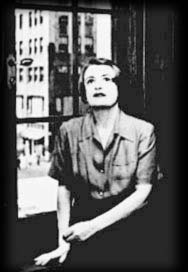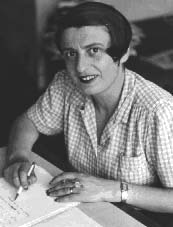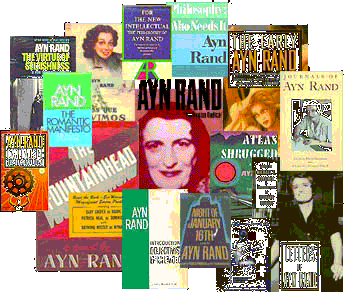 |
 |
|

Writer's Box|LinksURLs|Fractals|3Bs|Note|Freedom|Search|CatInHat
 |


By Christine Chambers @ Empire:ZINE - May 1998
Additional information added in [brackets].
On February 2nd, 1905, Alice Rosenbaum was born in St. Petersberg Russia. Her early life
was comfortable, and she received a good private school education. In her early teens,
this all changed. Following the Bolshevik Revolution, her father's business was
nationalized, and the family's comfortable life came to an end. Alissa never forgave her
country this betrayal, and would for the rest of her life speak out against the sacrifice
of the individual to the common good.
In 1918, the family fled to the Crimea to escape the civil war, and it was during her
three years there that Alissa declared herself an atheist. During this formative time, she
discovered the awesome power of Victor Hugo, who wrote massive novels about heroic people
fighting against great adversity. Although her decision to become a writer had been made 4
years before, it was Hugo's writings that told her what kind of stories she wanted to
create.
In 1921, Alissa returned to the city of her birth and entered the University. Her novel We
The Living is an obvious reflection of her University years, as well as of a doomed love
affair that she experienced during her 4 years there. She graduated with a degree in
history in 1925, the same year she would receive an invitation to go visit relatives in
the United States.
She never expected her request for a passport to be granted, but when it was, the
determined young woman knew she would not be returning to Russia. During her passage to
the United States, she chose the name Ayn after a Finnish writer she admired. The last
name Rand was chosen soon after her arrival, and came from the Remington-Rand on her type
writer. Ayn Rand never saw her parents or older sister again, and although she did meet
with her younger sister 50 years later, the reunion was evidently unpleasant.
During her first few years in the United States, Rand worked in Hollywood as a movie extra
and scriptwriter for the Cecil B. DeMille studio. There she would meet and marry Frank
O'Connor [in 1929]. Although O'Connor was the man that Ayn Rand insisted was the model for
her heroes, by all outside accounts, he was a likable, handsome, passive, nonintellectual
alcoholic who never landed more than bit parts as an actor. Not exactly what one would
expect of the inspiration for Howard Roark, the protagonist of the Fountainhead. The
character of Roark - virile, decisive, sure of himself - is a commanding, unforgettable
presence. Though not necessarily Rand's ideal, she and O'Connor were married until his
death 50 years later. During that time, O'Connor offered his wife the financial security
and flexibility that allowed her the freedom of movement she would need to write and
lecture and develop her philosophy. For the remainder of his life, back and forth between
Hollywood and New York he followed her, bending to her will, learning new trades as
necessary to support her. One wonders if Rand could have realistically lived with a man
like Roark.
From 1929 to 1932, Rand worked in the wardrobe department of R.K.O. studios. She hated
this job. In 1932, she finally sold a screenplay called Red Pawn to Universal pictures.
Though this should have been Rand's first major triumph, it proved to be little more than
a frustration. Universal ended up trading the screenplay to another company, who later
changed their mind about producing it. The only benefit Rand received was $1500, which
afforded her the opportunity to leave R.K.O. and pursue writing on a full time basis.
In 1934, a play that she had called Penthouse Legend opened in Hollywood as Woman On
Trial, and made Rand famous. The following year, she took a risk that nearly floored her.
She and Frank moved off to New York and lived on the edge of poverty, all so that her play
could be produced on Broadway. During this time, Rand lost all control of the play, which
under contract to A. H. Woods, was changed so much it was nearly unrecognizable. The title
now became The Night of January 16th. In spite of all this, the play was an immediate
success, and enjoyed a long run on broadway. It was not until 1968 that the manuscript was
published in its original form.
That was a bad year. She had completed but could not sell We The Living, New York was not
friendly, and the heroine of The Fountainhead, which she was writing at this time, was a
reflection of her overall negative attitude. When We The Living finally did sell [in
1936], it received mixed reviews, which would establish the pattern of reception for all
of Rand's major works of fiction: mixed reviews and poor sales at first, with each piece
becoming more popular with time.
 The
Fountainhead was a major turning point in the direction of Ayn Rand's writing. To make the
book its best, she took an unpaid job in an architectural firm for nearly a year. She was
gearing up to write a great novel about a heroic architect, the aforementioned Howard
Roark. The novel is actually about four men. Roark is the protagonist. Peter Keating,
another architect, is his opposite. Where Roark experiences failure in the beginning, but
heroism in the end, Keating enjoys early success, but because he looks to others for
guidance, and is sorely lacking in self-esteem, he loses the control of his own fate that
Roark has always had. Gail Wynand, a man with all of Roark's heroic potential, tragically
gives in to the will of society. Ellsworth Toohey, whose primary drive was to have power
over other men, is the antagonist of the work. Surrounded by these men - all powerful in
there own way - is Rand herself in the guise of Dominique Francon, a vampire drawing
sustenance from each of their egos. Early on, Rand decided that instead of a story where
the main character was eventually dragged down - as in her other fiction - this was to be
a story of one man's ultimate triumph over great adversity.
The
Fountainhead was a major turning point in the direction of Ayn Rand's writing. To make the
book its best, she took an unpaid job in an architectural firm for nearly a year. She was
gearing up to write a great novel about a heroic architect, the aforementioned Howard
Roark. The novel is actually about four men. Roark is the protagonist. Peter Keating,
another architect, is his opposite. Where Roark experiences failure in the beginning, but
heroism in the end, Keating enjoys early success, but because he looks to others for
guidance, and is sorely lacking in self-esteem, he loses the control of his own fate that
Roark has always had. Gail Wynand, a man with all of Roark's heroic potential, tragically
gives in to the will of society. Ellsworth Toohey, whose primary drive was to have power
over other men, is the antagonist of the work. Surrounded by these men - all powerful in
there own way - is Rand herself in the guise of Dominique Francon, a vampire drawing
sustenance from each of their egos. Early on, Rand decided that instead of a story where
the main character was eventually dragged down - as in her other fiction - this was to be
a story of one man's ultimate triumph over great adversity.
In 1943 The Fountainhead was published at the insistence of Bobbs-Merrill editor Archibald
Ogden, who had such faith in the manuscript that he threatened to quit the firm if it was
refused. Although Rand was later criticized on this point for being the recipient of
another person's altruism, she believed that he was acting out of self-interest. She said
that he was fighting to be the one to discover a great work of literature. This may well
have been true, as the mammoth novel became a perpetual success, if not an immediate one.
The sale of the screen rights later that year made Rand a wealthy woman, though the film
could hardly be called a success.
Following this triumph in 1946, Rand was finally able to publish Anthem - an Orwellian
style story of one man's struggle against a collectivist system - in the United States.
Although written during one brief summer in 1937, the novella had been previously
published only in Britain [in 1938].
Throughout the 1940's, Rand had begun to involve herself in politics; first with her
support of the doomed Wendell Willkie against the popular Roosevelt, whose social programs
she detested. The same year Anthem was released in the United States, Rand involved
herself in the postwar effort to find and punish leftist Hollywood writers and actors. At
this time, there was great hostility towards Russia. Russian sympathizers were accused and
penalized. Rand volunteered to point the finger at those she felt had kept her from
delivering her message for so long. So in 1947, Ayn Rand testified before the House
Un-American Activities Committee against the "Hollywood Ten."
1950 was an auspicious year for Rand. Not only did she begin work on what was to be her
masterpiece, but she met Nathaniel Branden and his future wife Barbara. Branden had
written her a fan letter concerning The Fountainhead, and she immediately recognized a
kindred spirit. Although she would eventually have a mysterious and scandalous falling out
with him, at the time she declared him her "ideal reader" and intellectual heir.
He was even allowed the honor of reading Atlas Shrugged as it was being written. When it
was published in 1957, it would be dedicated jointly to Branden and her husband. The two
would remain inseparable for the next 18 years.
Throughout this partnership, Rand would slowly earn respect as more than just a fiction
writer. In 1958, in an interview with Mike Wallace, she drew the attention of many with
comments that condemned altruism in America, supported capitalism as the foundation of all
political freedom, and denounced the Christian cross as a symbol of torture. She declared
instead as her symbol the dollar sign. In 1961 she published her first philosophic
treatise and entered a new phase of her writing career. The 1960's were dedicated to the
founding of the Objectivist movement, lecturing, and essay writing, interrupted only by
her support of Barry Goldwater in 1964 and her falling out with Branden in 1968 [following
certain infidelities on his part]. Goldwater she believed to be the kind of
"Atlas" who would bring America back to capitalism. His loss only confirmed
Rand's conviction that the United States was headed in the wrong direction. As for her
split with the Branden, much ugliness and mud was slung on both sides, and it ended in her
declaring a new leader for her movement, Leonard Peikoff. There was plenty of bitterness
available for all, and more about this story can be found in Barbara Branden's book The
Passion of Ayn Rand.
Until 1976, Rand continued to produce essays in the form of newsletters to her followers,
just as she had done in the 60's, but with less and less frequency and enthusiasm as her
health began to decline. When in 1979 Frank O'Connor died, time was also running out for
Ayn Rand. In 1981, she briefly roused herself to make one more speech for Monetary Reform,
and to reconcile with Barbara Branden. [On March 6, 1982], she died in her Manhattan
apartment her only company, a professional nurse.

Return
to Ayn Rand.